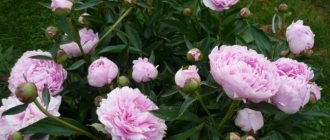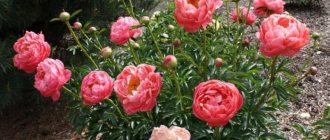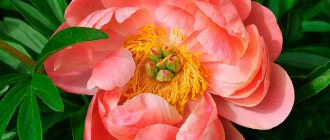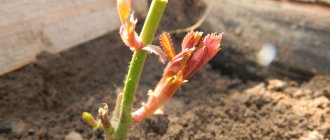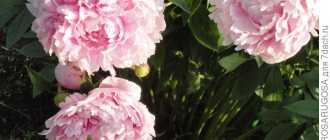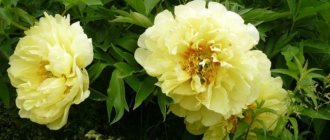Preparing for winter
Pre-winter pruning of the stems of ITO hybrids is carried out after the plants begin to wither, but before the onset of constant cold rainy days.
After pruning, stumps 2-3 cm high should remain on the soil surface. Winter-hardy ITO hybrids can suffer from frost in a snowless winter, so you need to make a decision about insulating peony bushes based on actual weather conditions. As mulch, agrofibre folded in several layers, spruce spruce branches, rotted sawdust, and a mixture of sand and peat are used.
People who grow Itoh Canary Brilliants hybrid peonies can be considered truly lucky. Indeed, in their gardens, in the flower beds in early spring, luxurious flowers bloom, the sight of which evokes delight and admiration.
The climate in the Moscow region is complex, unstable, spring is late, autumn is short, in summer there is a sharp change in temperature, and it often rains. In winter, severe frosts are constantly replaced by thaws. In such conditions, only the most unpretentious plants survive. Peonies cannot be called too capricious, however, not all varieties take root in the Moscow region.
Peonies are divided into 3 subspecies - herbaceous, tree-like and artificially bred ito-hybrids. There are a little more than 40 species of flowers, and the number of their varieties can no longer be counted; they appear every year. Varieties that are frost-resistant, with strong immunity to high humidity, diseases, pests and frequent weather changes are suitable for growing in the Moscow region; we will highlight the best of them with photos and descriptions.
Predecessors of intersectional hybrids
The history of intersectional peonies is long, and it began in the last century (1900 - 1935), when two Frenchmen - Victor Lemoine and Louis Henry - were the first to create yellow peonies for the garden by successfully crossing the wild yellow tree peony (P. lutea) with large-flowered tree peonies ( P. suffruticosa). The result was a group of wonderful garden plants known today as lutea hybrids. Although at that time they were an achievement in themselves, their significance for the peony world was not yet entirely clear, since they were to become the basis for further achievements.
This work was continued and expanded by the great American plant breeder Dr. A.P. Saunders, who created and registered 75 Lutea hybrids in the 1940s and 1950s. Again, this man, who did so much for the world of peonies, had 2 nameless and unregistered F2 hybrids, which he gave to the breeder Nassos Daphnis and to the nursery of William Gratwick (New York). Daphnis understood the significance of these strange plants and used the ugly but fertile F2 hybrids in numerous crosses with F1 hybrids, as well as with the best Japanese tree peonies. Thus, he received a new set of recurrent lutea hybrids, some of which had their fertility restored. Dr. David Rieth, in turn, used some of the fertile hybrids from Daphnis to create several highly fertile lutea hybrids, such as 'Golden Era', which has become famous in peony hybridizing circles. Although Dr. Rieth also created numerous outstanding yellow tree peonies and herbaceous hybrids such as 'Alice in Wonderland' and 'Lemon Chiffon', his greatest contribution was the less impressive but highly fertile 'Golden Era', thanks to its seminal role in a long line of creating intersectional hybrids. Fortunately, Rith recognized the value of his new seedlings to other breeders and distributed them (as unnamed seedlings A-198 and 199) for use in breeding purposes. As a result, hybrids such as A-199 were widely used by Roger Anderson, Don Smith, Irene Tolomeo and others, who created hundreds of exciting new cross-sectional hybrids. This final result would not have been possible without the decisive first step of Lemoine and Henry and any of the intermediate steps taken by Saunders, Daphnis and Rith along the way. This story highlights the extraordinary achievement of Ito, who was able to achieve crossbreeding success even though he only had relatively infertile F1 lutea hybrids to work with, like Lemoine's 'Alice Harding'.
| Peony Lolipop by Roger Saunders | Peony Morning Lilac by Roger Saunders |
Description of Paeonia Itoh Canary Brilliants
The Canary Brilliants peony is part of a group of elite, prestigious plants from the genus Paeonia, famous for the unique colors of its petals. The hybrid was created in 1999 by the American hybridizer R. Anderson. In 2010, Itoh Canary Brilliants was awarded the American Peony Society's Award of Landscape Merit.
Each stem of the Itoh Canary Brilliants peony bears up to 4 buds. In light partial shade, semi-double inflorescences of the Canary Diamond peony change their color during the flowering period from pinkish, soft peach to yellow shades. The bases of the petals, wavy along the edges, are colored reddish.
Note! In an open, evenly sunny growing area, the Kenery Diamond peony will be completely colored in bright peach or yellow shades. The bush blooms for about 3 weeks.
Flowers have stamens and pistils, but no pollen, so once the flower fades, no seeds are produced. In a bouquet placed in a vase with water, cut peony branches do not lose the petals of the inflorescences for 10 days. Flowers smell nice
The bush blooms for about 3 weeks. Flowers have stamens and pistils, but no pollen, so once the flower fades, no seeds are produced. In a bouquet placed in a vase with water, cut peony branches do not lose the petals of the inflorescences for 10 days. The flowers smell nice.
The bushes have a spreading, raised shape, dense branching, dense foliage, and strong peduncles. The plant as a whole looks lush and massive. The stems of the flower, up to 80 cm high, do not bend to the ground even during the period of mass bud opening.
The size and appearance of the leaf blades of the Kenery Brillint peony received from a tree-like ancestor. During the growing season and flowering, the leaves are colored a rich dark green; in August their color changes and becomes bronze-burgundy.
Note! The already faded peony ITO Canary Diamonds does not lose its decorative effect until the first frost. It is widely used to create multi-tiered mixborders, in rock gardens, linear and group landscape compositions, for single cultivation
Opened flower and bud of peony ITO-hybrid Canary Diamond
Application in landscape design
Peony Canary Diamond looks great in the garden, not only due to its beautiful buds and abundant flowering, but also its green spreading bushes. They are often grown in plain sight, for example, in the center of a flower bed, at the entrance to a house, near a gazebo. For a single planting, a lawn is ideal, which will become a spectacular backdrop for the flower. Peony bushes of this variety are quite tall, so they can be planted along paths, keeping an interval of 1 m between plants.
Canary Diamond fits perfectly into the following compositions:
- near a pond or terrace;
- rock gardens;
- flower beds;
- mixborders.
Peonies combine harmoniously with ornamental crops and other flowers. Next to them are grown: dwarf conifers, irises, roses, ground cover plants, hydrangeas, lilies, tulips, daffodils. When developing a composition, it is necessary to take into account the size and color of the crops. Since the bushes of this variety are quite large, they are often used to decorate the background, after which a flower bed of other crops is formed.
It is not recommended to grow trees and large shrubs that can create shading near peonies. As a result, the flower will not be able to grow and develop normally. It is not advisable to place buttercups nearby, as they grow quickly and take away nutrients and moisture from the main plant.
Landing
It is better to plant peonies in August or September. Peonies "Canary Diamonds" are undemanding to the soil, and they are quite happy with clean loamy soil with neutral acidity. But the close location of groundwater is completely undesirable for them. In these circumstances, an artificial embankment drainage layer will be required. In this case, the landing site should be illuminated by the sun or be slightly shaded.
Ito-peonies are propagated mainly by divisions, each of which should have from two to five healthy buds and roots.
Care must be taken to ensure that peonies have enough space to grow. A distance of a few meters from the nearest neighbors in the garden would be ideal.
To plant Canary Diamonds ito-peonies, prepare holes measuring 70x70x70 cm. The peonies themselves should be planted at a distance of 1-1.5 meters from each other. The lowest layer is filled with drainage from small pieces of brick, pebbles or expanded clay to about 15 cm. The next layer is filled with compost and mineral fertilizers.
Drainage and compost pits are left alone for a week. During this time, they will settle, and you can start planting. To do this, the root of the bush is placed in a hole, covered with earth and compacted. Vegetative buds must be left at a level of at least 5 cm.
Peonies cannot be buried; deeply planted ones do not bloom.
Peonies begin to be watered with the onset of spring. The soil should be moistened, but moisture should not stagnate. About two or three buckets of water should be poured under a mature Canary Diamonds peony bush. If the ground around the peonies is not mulched, then weeding and loosening are mandatory. Mulching is covering the soil with various materials to reduce moisture loss and prevent soil cracking, and straw works well as the simplest mulch.
Peonies should be fed in three stages: as soon as the snow melts, 10 grams of potassium and nitrogen are scattered around the bush, then watered; during the period of bud growth, 10 grams of nitrogen, 12 grams of potassium, and 15 grams of phosphorus are also scattered; Fertilizers are applied for the third time two weeks after flowering. To do this, add 12 grams of potassium and 20 grams of phosphorus under each bush.
It is not recommended to apply nitrogen fertilizers during flowering, since in this case the plants will spend all their energy on developing leaves and stems.
To deoxidize the soil, it is recommended to use dolomite flour and ash. They can be added to the soil at any time of the year, but the preferred period for their application is spring or autumn. Dolomite flour is applied to the soil once every three years. Ash has less pronounced deoxidizing properties, so it can be added more often.
Protection from diseases and pests
Peony of this variety is not susceptible to diseases, provided that the rules of agricultural technology are followed.
The main diseases of this variety and their symptoms:
| Disease | Description |
| Powdery mildew | The most common disease. The causative agent is a fungus. It often develops in soil oversaturated with nitrogen fertilizer. At the initial stage, fungal spores infect the lower part of the plant, spreading upward through the bush. Gradually, the disease affects the entire bush. A white coating is observed on the surface of leaves and stems, which quickly spreads and becomes dense. At first it has a light shade. If measures are not taken in a timely manner, the peony will wither and eventually die. |
| Gray rot | The fungus affects all parts of the bush. A milky or white cotton wool-like coating is observed on the leaves, stems, petioles, flowers and buds. Under the lesions, the tissues rot, acquire a brown tint, and the buds do not open. The leaves become deformed and dry out. The disease spreads quickly in warm and damp weather, especially if the peony grows in shade. |
When the first signs of the disease are detected, it is recommended to spray the bushes with a solution of copper sulfate. Pests to watch out for are turf ants and root-knot nematodes. In some cases, peonies are attacked by the bronze beetle. Treatment with chemicals helps in the fight against insects: Aktara and Kinmiks.
You can grow hybrid peony in almost any region. The Canary Diamond variety does not require care and is characterized by a high level of frost resistance. Flowering begins already 3 years after planting, and after 5 years the plant acquires the best decorative properties. This culture will become a real decoration of a garden or flower garden.
Varieties of pink peonies growing in the Moscow region
Very popular among gardeners are varieties with flowers painted in different shades of pink, symbolizing tenderness, love, purity and meekness. Petals can be from delicate pastel colors to almost black magenta.
There are most of these varieties, we have already noted several of them above, now we will highlight the most beautiful and luxuriantly blooming ones:
- Madame Butterfly. Belongs to the Japanese group of herbaceous, terry peonies. The lower, wide petals are pink-lilac, and the inner, narrow petals are crimson. The diameter of the inflorescence is about 18–20 cm.
- Hilary. A miniature ito-hybrid, the bushes rarely grow above 70 cm. The flowers are up to 17 cm in diameter, semi-double, pink at first, gradually acquiring a creamy hue. There is a distinct red spot at the bottom of the petals.
- Sarah Bernhardt. An ancient, herbaceous, double variety that blooms in mid-June. Each bush opens with 4–5 pink flowers, the first 15–20 cm in diameter, the rest no larger than 12 cm.
- Bouquet of pink carnations. The shape of a tree peony with crown-shaped, fluffy, very delicate flowers, 18 cm in diameter. Bush up to 1.5, blooms profusely from the end of May.
- Typhoon. A herbaceous variety with pink, double flowers (16–19 cm across). The petals are dark crimson in color; in good sunlight, a light chocolate tint is noticeable. Bushes up to 75 cm.
A few more unpretentious pink peonies that are resistant to cold and high humidity: Albert Kruss, Dresden Pink, Jubilee, Coral Pink, Madame Boulanger, Premiere, Skarbnitsa, Svetlana Udintseva, Monsieur Jules Ely, James Pillow, Mrs. F. D. Roosevelt, Top Brass . Less popular, but also noteworthy varieties: Princess Margaret, Pink Raidians, Polonaise, Dinner Plate, Rose Marie Line, Lady Kate.
Peonies IV
Status: Offline
Peonies IV
Message from Sveta_80 » 06/10/2012, 17:33
pro Messages: 4047 Registered: 03/10/2006, 21:22 From: Vladimir province Thanked: 795 times Thanked: 528 times
Status: Offline
Message from Svetlana » 06/12/2012, 18:53
Messages: 495 Registered: 03/26/2010, 00:00 From: Moscow Thanked: 19 times
Status: Offline
Posted by ulik » 06/13/2012, 22:46
Messages: 1954 Registered: 12/29/2006, 11:42 pm From: Moscow Thanked: 65 times Thanked: 163 times
Status: Offline
Posted by limon » 06/15/2012, 13:35
Status: Offline
Message from Alenka » 06/19/2012, 21:26
Messages: 16039 Registered: 04/30/2009, 19:43 From: Moscow Thanked: 7993 times Thanked: 11629 times
Status: Offline
Message from Anin » 06/19/2012, 21:58
pro Messages: 4047 Registered: 03/10/2006, 21:22 From: Vladimir province Thanked: 795 times Thanked: 528 times
Status: Offline
Message from Svetlana » 06/19/2012, 22:03
Messages: 16039 Registered: 04/30/2009, 19:43 From: Moscow Thanked: 7993 times Thanked: 11629 times
Status: Offline
Message from Anin » 06/19/2012, 23:38
Light, if you’re offended by all the confusion. I don't even know what to write. There are not enough beeches))))
Come to Bud. year, my Primavera will be three years old, I’ll save you from him.
Passed away Messages: 9103 Registered: 04/04/2009, 13:23 From: Lipetsk Thanked: 6824 times Thanked: 2278 times
Status: Offline
Posted by Esme » 06/20/2012, 10:24
Status: Offline
Message from Alenka » 06/20/2012, 10:32
Passed away Messages: 9103 Registered: 04/04/2009, 13:23 From: Lipetsk Thanked: 6824 times Thanked: 2278 times
Status: Offline
Posted by Esme » 06/20/2012, 10:44
Messages: 1894 Registered: 02/24/2009, 00:29 Interests: gardening, floriculture Occupation: working with children From: Moscow, Mitino, dacha in the Klin district Thanked: 813 times Thanked: 935 times
Status: Offline
Posted by tab301 » 06/20/2012, 13:17
Messages: 16039 Registered: 04/30/2009, 19:43 From: Moscow Thanked: 7993 times Thanked: 11629 times
Status: Offline
Message from Anin » 06/20/2012, 15:38
Status: Offline
Message from Alenka » 06/20/2012, 20:19
Nina, there are several “crested” varieties. And finally, it’s not so easy to determine the variety, there are so many nuances.
Tamara, I have these too.
Messages: 16039 Registered: 04/30/2009, 19:43 From: Moscow Thanked: 7993 times Thanked: 11629 times
Status: Offline
Planting and care
Typically, peonies begin to be planted in late summer or early autumn (permissible in April). Choosing a place is quite simple - it should be open, well lit, without drafts. The soil should be light. Since peonies do not like stagnant moisture, it is preferable to choose a small hill rather than a lowland. If possible, bushes can be planted near a house or fence to protect them from strong wind gusts.
Before planting the Canary Diamonds peony, you need to prepare in advance a fertile mixture of compost and garden soil (2:1). It is useful to add 200 g of superphosphate fertilizer and 60 g of potassium salt to them. The algorithm is as follows:
- First, the area is cleared and dug up to 25-30 cm.
- Create several holes with a minimum interval of 70-80 cm.
- Lay a layer of drainage (pebbles, expanded clay, broken brick).
- Add a fertile mixture and root the seedling.
- Water generously and mulch with pine needles, hay, straw and other available materials.
Plant care
In order for an ornamental plant to delight with its bright greenery and abundant flowering, no special care is required. It is enough to maintain soil moisture, periodically fertilize the bushes and, if necessary, treat them against pests.
Watering and fertilizing
Watering the bushes begins in early spring. Each bush requires 2-3 buckets of water, which is applied to the root zone. The frequency of watering may vary and depends on the climatic characteristics of the region.
Note! The soil should always remain slightly moist, but waterlogging will cause the rhizomes to rot. It is recommended to fertilize the Ito Canary Diamonds peony 3 times per season:
It is recommended to fertilize the Ito Canary Diamonds peony 3 times per season:
- After the snow melts, nitrogen and potassium (10 g each) are scattered near each bush. After this, water the root zone.
- During the formation of buds. To the already mentioned components add 15 g of phosphorus.
- After the end of the flowering period (after 12-14 days), each bush is fed with potassium (12 g) and phosphorus (20 g).
To prevent the top layer of soil from drying out, the ground around the flowers is mulched. This term refers to sprinkling the soil with one material or another. This is done to reduce moisture loss and prevent cracking of the soil. For peonies, the easiest way is to sprinkle the ground with straw or peat.
To prevent bushes from becoming infected with fungal diseases, experienced gardeners recommend treating them with the biofungicide Fitosporin or a soap solution. It is better to carry out such procedures before the first signs of infection appear.
ITO-peony Julia Rose (Julia Rose)
Medium flowering variety. American selection, originator – Andersen, 1991.
One of the most popular varieties of ITO peonies in the chameleon category.
Herbaceous perennial, loves sunny places. Frost resistance zones 4-8. The height of the bush is 70-80 cm, the plant has strong shoots and grows quite slowly. The leaves are large, dark green, glossy.
The flowers are semi-double and double, about 18 cm in diameter, cherry-red in color, later fading unevenly to pink, peach and pale yellow with a cherry spot in the center. The petals are very thin. Flowers bloom one by one. The aroma is very light. Flowering duration is 0.5-1 month.
The flowers stand well as cut flowers. Peony is very resistant to pests and diseases.
Peonies after flowering
A real decoration of any garden will be ITO peonies - unpretentious and extremely elegant hybrids of your favorite flower, bred not so long ago and quickly conquering the market around the world. And for good reason – there are already hundreds of options in their sizes, shapes, colors and shades!
Of course, the once very rare yellow peonies are most in demand, but lovers of red, pink, white and even orange forms also have something to choose from ITO hybrids.
So, our TOP 9 ITO hybrids (peonies).
Medium-late flowering variety. American selection, originator – Andersen, 1999.
The flowers are double or semi-double, large (about 15-20 cm in diameter), several delicate shades of pink-yellow with a dark orange-yellow spot in the center. The petals are slightly “corrugated”. Flowers bloom one by one. The aroma is very light. Flowering lasts 2-3 weeks.
The flowers stand well as cut flowers.
The Canary Brilliants flower is an Ito hybrid, which is classified as semi-double or double. Breeders managed to develop this variety by crossing two types of peonies: herbaceous and tree-like.
Peony Canary Diamond
Peony Canari is presented in the form of a bush of the Ito group, which consists of several strong stems and most often reaches a height of 90-100 cm. In the absence of thinning, the bush can branch strongly and reach a diameter of 80-90 cm.
On a note! The largest buds reach a diameter of 20 cm. Slightly wavy petals at the beginning of flowering have a delicate color (cream, pink, yellowish), but by the end of the period they darken.
Peony Itoh Canary Brilliants has a number of main advantages that cannot be ignored:
- Frost resistance. Adult plants with additional shelter can withstand up to -25 ℃.
- Unusual coloring. In the spring, at the beginning of flowering, the buds have delicate soft shades, and by the end of summer they become more saturated and dark.
- Most hybrid peony varieties are characterized by large buds and a large number of flowers on the bushes.
- Well accepted after breeding.
Among the shortcomings, only 2 factors can be named:
- They react poorly to heat. If summer in the region is accompanied by high temperatures (more than 25 ℃), then the bushes should be planted in semi-shaded places.
- Sensitivity to watering. Over-moistening of the soil should not be allowed.
Peony Kenery Diamond can successfully fit into any garden design. This plant can be used for several purposes:
Solo. On a green, well-groomed lawn, peonies (one or several bushes) will look most impressive
In this case, nothing will distract attention from large double flowers. In mixborders. Roses, clematis, and phlox are suitable as neighbors for peonies.
They are also planted next to coniferous trees: small pines or junipers.
Peony Canary Diamond in landscape design
The flowering period of the plant is relatively long, with many large velvet buds appearing on the bushes. To maintain the beauty of peonies, they require additional care during this time.
The young Brilliant peony usually does not produce flowers in the first 1-2 years. When flowers appear, they are often irregularly shaped. Cutting the buds helps fix this. Starting from 3-4 years, the plant is considered an adult and actively blooms from late April or early May. The end of the flowering period occurs at the end of July.
Peonies bloom actively for a long time. This takes a lot of energy from the plant. To constantly maintain flowers in good condition, you should be careful about regular watering and fertilizing.
It is important to know! The first application of fertilizers is carried out from the moment the buds appear
Peony feeding
If a plant does not produce flowers in 2-3 years of life, there may be several reasons:
- Lack of sunlight.
- Acidified soil. Lack of fertilizers. The plant simply does not have enough resources to form buds.
- Excess nitrogen fertilizers. With this feeding, increased leaf formation occurs.
- Excess or lack of moisture.
Transfer
Transplantation for the purpose of propagation is recommended to be carried out in the fall after the flowering period or in early spring. If the latter option is chosen, then you can divide the bush until it has red shoots reaching a height of 15-20 cm.
If the bush needs to be transplanted to another place without dividing, this can be done in the summer.
Preparing for winter
In late autumn, the flower stems are cut off, leaving columns no higher than 3-5 cm. In areas with cold winters, the Ito hybrid Canary Diamond peony is covered with spruce branches or sawdust.
Additional Information! Plants should not be covered with film for the winter. Due to the greenhouse effect, the rhizomes and above-ground parts rot.
Growing a flower, how to plant it correctly in open ground
The health of the plant, its growth and flowering largely depend on proper preparation and planting.
For this reason, you should pay attention to the preparation of the soil and planting material
The easiest way to plant these flowers is to divide the bush. In order for the plant to grow quickly, you need to choose the right mother bush.
In this case, it is important to comply with a number of conditions:
- The donor plant should not be too young. The best age for breeding is 3-4 years. At this time, a large number of buds already appear on the bushes.
- The rhizome of the flower should be well developed.
Note! A small part of it (about 10-15 cm in size) is separated from the common rhizome. There are 2-5 buds on this division
Dividing the mother bush and planting the division is best done in the fall. August and the first half of September are good. Overwintered peonies will actively begin to grow in early spring.
Peony Canary Brilliants takes root well in loamy soil, the acidity of which is close to neutral. Flowering activity directly depends on the degree of illumination, so it is better to choose a site in the sun or light partial shade.
Important information! To ensure that the bushes can grow freely, peonies should not be planted close to other trees and shrubs.
First of all, a pit with dimensions of 70×70×70 cm is organized. The distance between peony bushes should be at least 0.7-1 m. Several layers are laid at the bottom of the pit:
drainage, because excess moisture has a bad effect on the growth and appearance of flowers, so it is important to provide a drainage layer of 15 cm; compost and fertilizers, which use mineral compounds.
When landing, the following types of work are performed:
The rhizome with buds is placed in a pre-prepared hole. Carefully fill the hole with earth. In this case, you need to ensure that the buds are no deeper than 5 cm from the surface of the earth. The earth is compacted and left to overwinter.
Peony propagation by rhizome
Planting by seeds
Summer residents and flower growers practically do not use this method of planting. Dividing the rhizome allows you to solve the problem of reproduction as efficiently as possible with minimal effort.

